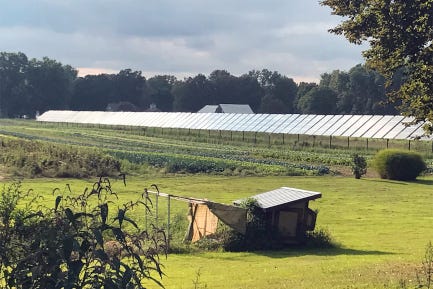Agrivoltaics—Solar Farms on Farms or Solar Greenhouses
Solar farms don’t have to destroy farm or ranch land.
In fact, they can co-exist as Agrivoltaic farms, which includes Solar-Powered Greenhouses.
Many farmers and ranchers across America and in many other countries are making dual use of their land by adopting a solar + agriculture model known as Agrivoltaics.
These ranchers and farmers generate income from their crops or livestock—and also from leasing their land for solar power generation.
However, Agrivoltaic farms don’t magically happen, just because thousands of solar panels are plopped on some farm or ranch land.
Agrivoltaic systems require more planning and design than an ordinary solar farm; and it costs somewhat more to build an Agrivoltaic farm or ranch.
Solar arrays need to be installed high enough off the ground to enable live-stock and farm equipment to pass under the arrays. Different crops need more or less exposure to light, so spacing and orientation of panels needs to be determined. There's modelling software available to assist in this design; and, if crops need certain light-levels throughout the day, there's AI-driven electronics available to automatically control the needed angle of panels.
Elevating panels has additional potential benefits. In heavy snow country, deep snow wouldn’t partially bury the panels. Depending on local electrical codes, elevated panels might eliminate the need for safety fencing surrounding the array complex. If so, eliminating such fences could preserve existing wildlife thoroughfares.
You get what you pay for, and the higher startup cost is worth it.
On an Agrivoltaic farm, the land is more productive; more energy is likely produced; bird- and bee-friendly environments can be created; and both land-owner and solar farm investor are likely to be more profitable.
References
Clicking on a reference opens a new window. To return to this page, just close the new window
A Collage of Agrivoltaic Farms from Around the World, with Linked Articles
Agrivoltaics proving a responsible way to blend solar fields and traditional ag
The Effects of Solar Farms on Local Biodiversity: A Comparative Study
Bluewave Solar Energy Development—AgriVoltaic Success Stories
AgriVoltaics2021, Conference and Exhibition, 14-16 June 2021, Online Event
Pollinator-Friendly Solar Installations Benefit Wildlife, Farmers, Climate (2020)
DIY Research suggested search terms: agrivoltaics companies or agrivoltaics research or agrivoltaics
Clicking on a reference opens a new window. To return to this page, just close the new window
Author’s Opinions
Rather than massive centralized solar farms, we need to put solar panels on all residential and business roof-tops in every city located in useful solar irradiance regions. And in rural agricultural areas, many small farms could become Agrivoltaic.
These roof-top solar-electric generators could be connected using conventional grid-tie electronics. Each roof-top generator could have its own battery storage. Each existing local grid substation would also include battery storage. As envisioned, this would use the existing national grid power transmission lines; and the existing national power management, control and routing system. Ultimately, as battery energy density quintuples in the few years, this energy system would render conventional power generation obsolete (conventional includes hydroelectric, gas and coal).
Rural agricultural areas are included in this distributed energy system, as Agrivoltaic farms (which is explained above). In brief, we can achieve 90% reduction in agricultural water use by shifting to Agrivoltaic solar greenhouses that support hydroponics, aeroponics, permaculture, and/or aquaculture for food production. This is described in detail in the “Possible Alternatives to Large Solar Farms” section.
The ideas above have been incubating since 2005, when I was undecided whether I support large-scale solar and wind farms. On one hand, we urgently need to divest ourselves from fossil fuels and shift to clean energy generation. On the other hand, for solar farms, there are no studies, that I know of, to determine the effect of putting hundreds or thousands of acres of land in partial shade, which previously had 100% sun exposure for perhaps thousands of years. What would the effect be on that ecosystem? One-thousand square feet of shade might have no effect at all. One square mile of shade might destroy an ecosystem. Without studying the potential effect(s), who can say for sure?
I’ve had a similar concern about wind farms. As wind farms proliferate around the world, at what point would harvesting the energy from the wind cause sufficient reduction of global air currents with consequent climate changes? Has that been studied? And yes, it might be ironic that to avert fossil fuel induced climate change, we establish so many wind farms that we cause climate change. We need to model this and determine whether this is realistically possible.
In 2006, a group of small business owners were discussing installing solar panels on the roof-tops of their businesses along Mississippi Avenue in Portland, OR. I was participating in the discussion, where one good idea led to another, until finally, I had an epiphany. As a computer systems professional, it was a short step to the idea of networking all the panels and establishing a shared energy storage capability, analogous to network attached storage (NAS) for data.
All the excitement of going forward with this shared energy system quickly dissipated when the cost was calculated. In 2006, the cost of PV panels alone was prohibitive at ~$4.00-$6.00 per watt (in 2021, panel cost has dropped to ~$0.50-$0.70 per watt). And that cost was just for panels. It didn’t include inverters, charge controllers, racking, batteries, copper wire, and installation! It was way too expensive to be viable in 2006!
The idea persisted, and it has evolved from a few roof-tops on Mississippi Avenue to a national distributed power generation and energy storage system.
It makes use of land that’s already covered by city and suburban structures.
Land already used for agriculture can also be used for power generation in rural areas.
Power generation is distributed, not centralized, and consequently, it’s more robust and resilient




